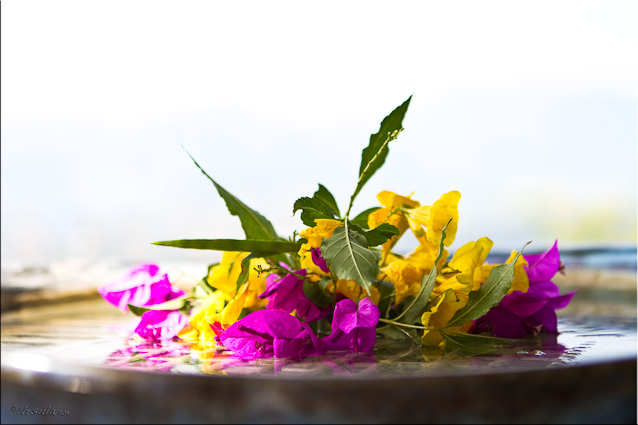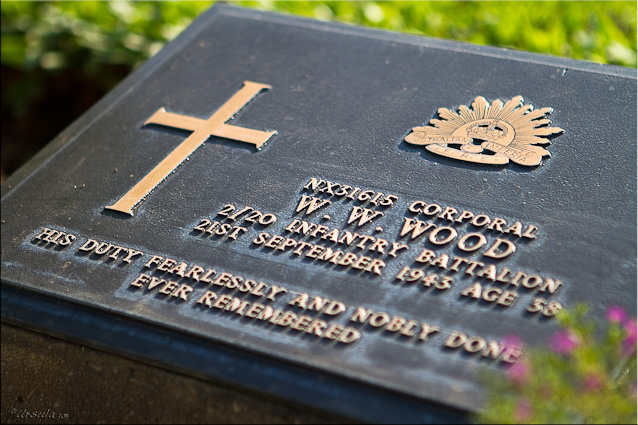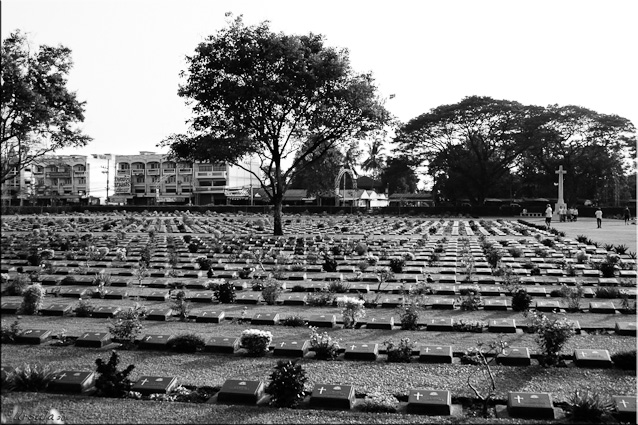
Flowers for Peace, Hellfire Pass Memorial Museum, Kanchanaburi (Photo: 29/12/2010)
ANZAC Day is the official “Remembrance Day” for Australians and New Zealanders. First observed in 1916, it started as a tribute to the Australia New Zealand Army Corps (the ANZACs) on the anniversary of their landing on the beaches of Gallipoli in Turkey on April 25th, 1915 during World War I. It is said that as many as 650 ANZACs died that day, with about 2000 casualties – and a legend was born.
Today the meaning of ANZAC, while not entirely uncontroversial, has come to include all Australian and New Zealand service personnel. According to official Australian Army documents, ANZAC Day is celebrated “all over the two nations and wherever Australians are overseas. It is our day – a day to remember with affection the courage of people and the value of friendship – to honour the dead and to acknowledge those who suffer still from the effects of war. We do not celebrate victory or glorify war – we celebrate the human spirit – the spirit of ANZAC.”

“His duty fearlessly and nobly done – ever remembered.”
I am no fan of war. But, I take no issue with paying respect to those who serve their countries and who either come back changed, or don’t come back at all. I have no doubt that many who serve do NOT live up to the stereotypes that are bandied about as part of the the ANZAC myth: courage, endurance, irreverent good humour and egalitarianmateship. But then, until we are under the same pressure, none of us know how we might behave.
“I have a conviction that it’s only when you are put at full stretch that you can realise your full potential”
– Sir Edward (Weary) Dunlop
Thailand was caught in the middle of World War II. In a bid to retain some independence, the Thai government allowed Japan ‘safe passage’ in the country. In practice, this meant that the Japanese stationed 150,000 troops on Thai soil and were able to force the building of their proposed supply line to Burma: the infamous “Death Railway”. About twenty-two thousand Australians were captured defending British territories in Asia and 13000 of these were among the 180,000 conscripted Asian labourers and 60,000 Allied Prisoners of War (POWs) transported to Burma and Thailand to work on the 420 kilometre Burma–Thailand Railway.

Kanchanaburi Allied War Cemetery (Photo: 09/02/2008)

“In honoured remembrance of the fortitude and sacrifice…” Kanchanaburi Allied War Cemetery (Photos: 26/12/2010)
The brutal conditions under which the railway was built cost 90,000 Asian labourers and 16,000 Allied POWs (including 2,815 Australians) their lives. Almost 9000 of these are interred in beautifully maintained cemeteries in Kanchanaburi where people can visit and pay tribute.

Life Among the Headstones Kanchanaburi Allied War Cemetery (photo: 26/12/2010)
It is somewhat ironic that the most notorious stretch of railway was started on ANZAC Day in 1943. The Japanese were running out of time, and this, coupled with the difficulties of the sheer expanse of rock to cut through, the remoteness of the area and the lack of proper tools, led to unimaginable conditions and a horrendous loss of life. For twelve weeks in tropical summer heat, POWs worked 12-18 hour shifts to build a 17 metre deep and 110-m long cutting through solid limestone and quartz using eight-pound hammers, steel tap drills, explosives, pinch bars, picks, shovels, hoes and bare hands. Work continued through the night, and the combination of the noise, the heat, the light from fires, bamboo torches and carbide lamps, gave rise to the name: Hellfire Pass (Thai: ช่องเขาขาด, Chong Khao Khart; Japanese: “Konyu Cutting”).

Jungle Vines Looking To The Tennasarim Mountains (Photo: 12/09/2009)

“… to all the men and women who suffered and died…” HellFire Pass Memorial Museum (Photo: 29/12/2010)

The Descent into Hell … … is much easier these days, thanks to the modern Australian Walkway. (Photos: 12/09/2009)
The beautifully laid out and maintained Hellfire Pass Memorial Museum, co-sponsored by the Australian and Thai governments, and managed by the Office of Australian War Graves, sits at the top of Hellfire Pass. Complete with air-conditioning, quiet, and clean toilets, it is a far cry from what the POWs endured. A wooden staircase takes you down into the Hellfire Cutting area. An area of the cutting has been cleared and one section of track from the original rails and sleepers has been relaid by Australian forces.

Konyu Cutting Short section of track, recovered in 1989 and relaid in 2006. (Photo: 26/09/2010)

Tribute to those who built the Thai-Burma Railway (Photo: 12/09/2009)
Against the odds, in spite of starvation, malnutrition, beriberi, pellagra, dysentery, malaria, overwork and beatings, many men survived. One of the best known Australian survivors was a Captain in the Royal Australian Army Medical Corps (R.A.A.M.C.), surgeon Ernest Edward Dunlop. In true Australian fashion, he was nicknamed ‘Weary’ – a pun on ‘Dunlop’, the makers of tyres/tires, and ‘tired’.

Rusty Railway Spikes and Ties (Photo: 12/09/2009)

Iron Spike, Railway Tie, Balsa Crosses and Poppies for Remembrance

Australian Flag and Remembrance Poppies, Hellfire Pass (Photo: 27/12/2010)
When Weary’s hospital in Bandoeng, Java was captured by the Japanese, he was amongst the first men to be sent to Thailand to look after his ‘work crew’ of over one thousand men (‘Dunlop Force’ or ‘Dunlop’s Thousand’). He was a true representative of ‘the ANZAC spirit’, and his ingenuity, bravery, and leadership skills were lauded by all he met, even his Japanese captors. Dunlop was tortured and beaten on numerous occasions, but never stopped behaving with dignity. After the war, said: ‘We must forgive but never forget’.

Memorial for Sir Edward “Weary” Dunlop (12 July 1907- 12th July 1993) (Photo: 12/09/2009)
Weary Dunlop survived the war and returned to Australia where he married his sweetheart, raised two sons, continued a distinguished medical career, was knighted, became Australian of the Year and an honorary member of the Returned and Services League, and was an exemplar of Buddhist forgiveness. He died July 1993. His ashes were spread at Hellfire Pass on ANZAC Day the next year .

Red Poppies for Remembrance; Koala for Australia (Photo: 27/12/2010)

Koala and Flowers for the POWs

End of the Track: Hellfire Pass
Another survivor of the Death Railway was Peter Rushforth, who returned to Australia to become an internationally recognised potter, and whose “Peace Vessel” has pride of place at the HellFire Pass Memorial Museum.

“Peace Vessel” by Peter Rushforth, against the Jungle and the Tennasarim Mountains, Kanchanaburi (Photo:12/09/2009)

It looks like there is no end in sight to war. Let us hope we can at least behave with dignity in the face of conflict.
(This post written and scheduled on March 26th, 2011. I’m currently ‘in transit’ somewhere.)






















.png)


as always just beautiful… may we learn that from war we actually need to avoid it, not to pursue it. RIP all those who have sacrificed in the name of peace and humanity.
Thanks, Signe! We never seem to learn, do we?
We visited Gallipoli last month. And spent almost 1 week . It was really great to see gallipoli, and troy. We almost saw all historical places of istanbul and then we went to troy for a day and saw the a of anzac. We are very happy and we definitely recommend it http://www.toursingallipoli.com Everything was fantastic and i saw all the places i want to. It was a great trip and i definitely recommend everyone. Thank you so much.
reminder of a time that must never repeat. I was there in 1991
greetings Dietmut
Indeed, Dietmut. A sobering place.